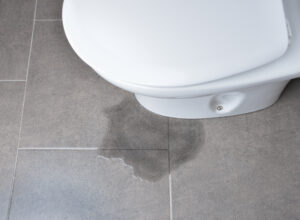How To Dye Test a Toilet for Leaks

The toilet is one of the most frequently used utilities in a home after the kitchen and is, therefore, susceptible to untimely wear and tear. Unfortunately, the signs of a leaky toilet, typically wetness or dampness around the floor, are only present when the seepage worsens.
If not addressed, a leak can cause costly and sometimes cause irreparable structural damage to your home. While most, if not all, toilet repair issues should be left to professionals, you can still dye-test your toilet to see if it leaks as you wait to call the plumbing experts at Herrmann Services.
What Are the Causes of a Leaky Toilet?
You may have a toilet leak if there’s water pooling around the base or if the bathroom floor is made of wood and feels ‘spongy.’ A big tell-tale sign, often ignored, is dampness on the room’s ceiling beneath the toilet, including a wafting smell of sewer gases emanating from your bathroom.
The most common reasons for a leaking toilet include the following:
- A damaged fill valve: Any damage to or misalignment of the fill valve that helps refill the toilet water tank might cause leaks or water level problems.
- The wax ring sealant coming undone: This can be from a botched DIY home improvement, or you’ve recently had to replace your toilet, and an unprofessional toilet installation has caused the wax ring to lose its seal and leak. The most common signs of a failing wax ring are a wobbling toilet when you sit on it, water pooling around the base, visible damage or mold on the floor surrounding your toilet, and a very unpleasant odor in your bathroom.
- Cracked toilet bowl or tank: While rare, you most likely have a damaged cistern when the water level in the toilet bowl is lower than “normal.” It may also be a cracked tank/bowl if you incur high water bills or repair costs because water seepage has resulted in severe structural damage.
- A faulty sewer vent line: If there isn’t enough free airflow in the vent to ensure proper pressure regulation inside the pipes, it could lead to water level issues in the toilet bowl.
- A toilet that frequently refills itself without being flushed is another indicator of a leak between the flush cistern and the bowl.
- Loose toilet bolts: This could be due to normal wear and tear, a warped toilet flange, rusted hinges, temperature changes, or the settling of a house that can make tightening a challenge.
If one or more of these issues cause a leak, consider doing a dye test for a toilet leak and have the problem fixed immediately. It’s also worth mentioning that a toilet leak can be a problem with the water supply line. However, this is a common and inexpensive repair job for a trusted plumber.
How to Dye Test a Toilet for Leaks
Most common leak issues begin in the toilet flush tank. Before conducting a toilet dye test, you want to inspect for any noticeable damage to the internal fill valve diaphragm seal that may require repairs or complete replacement.
Identifying a leak is often challenging until there’s moisture damage or you get high water bills in the mail. A specially-formulated powdery, liquid, or tracer dye tablet for toilets that come in blue, red, yellow-green, and orange can help identify leaks efficiently.
Follow these steps to run a toilet dye test.
- Remove the toilet tank lid by carefully lifting it and setting it aside.
- Once the lid is off, you should see a defined “Water Line” within the interior of the flashing chamber. Check if the water is at the indicated optimal level.
- Next is to check if the flapper is leaking; you’ll know this because it keeps triggering the fill valve to refill the cistern. Place a single tracer dye inside the toilet water tank to test for leakage and wait 15-30 minutes.
- If the dye has leaked out of the toilet bowl after 30 minutes and following a secondary test (with the water running), you may need to replace the overflow pipe or repair the leaking flapper.
- Check for loose or built-up debris collected around the flapper and clean the dirt off. If the leak persists after cleaning, the flapper may require replacing.
If a toilet flapper does not create a proper seal or the seepage is coming from the toilet base and tightening the tee bolts doesn’t resolve the issue, it’s worth calling the plumbing experts at Herrmann Services to stop further damage from occurring.
We’re available 24 hours a day, 7 days a week, 365 days a year to help with your Cincinnati plumbing emergencies
Don’t wait until your toilet leaks worsen before calling Herrmann Services – contact us today!